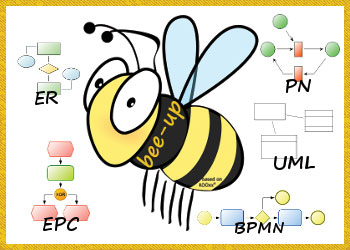

Search keywords:
 This tutorial presents an approach to semantic enrichment and digital twins based on conceptual modeling, demonstrated through specific features of the Bee-Up multi-language modeling tool which expands the value of conceptual models beyond their traditional functions. Bee-Up supports modeling with several established languages – e.g. BPMN, EPC, ER, UML, Petri Nets. The goal of the tutorial is to highlight how Bee-Up facilitates knowledge externalization and mediation for the “digital-first era” – firstly, in RDF format as it enables several layers of semantic enrichment towards a specific flavor of model-driven Knowledge Graphs; secondly, by interoperating with cyber-physical devices towards a specific-flavor of Digital-Physical Twin binding. Such features are show- cased during the tutorial, while also discussing the metamodeling approach that is under the hood of Bee-Up’s model processing capabilities.
This tutorial presents an approach to semantic enrichment and digital twins based on conceptual modeling, demonstrated through specific features of the Bee-Up multi-language modeling tool which expands the value of conceptual models beyond their traditional functions. Bee-Up supports modeling with several established languages – e.g. BPMN, EPC, ER, UML, Petri Nets. The goal of the tutorial is to highlight how Bee-Up facilitates knowledge externalization and mediation for the “digital-first era” – firstly, in RDF format as it enables several layers of semantic enrichment towards a specific flavor of model-driven Knowledge Graphs; secondly, by interoperating with cyber-physical devices towards a specific-flavor of Digital-Physical Twin binding. Such features are show- cased during the tutorial, while also discussing the metamodeling approach that is under the hood of Bee-Up’s model processing capabilities.Please register via the organizer.
As the tutorial allows for a hands-on participation you are invited to install Bee-Up on your PC in advance to follow the demonstration during the tutorial.
Further information on the Bee-Up tool is accesible online at https://bee-up.omilab.org.
HINT: The Imker Case study includes detailed instructions a) how to install Bee-Up and b) create your first conceptual models with the tool.